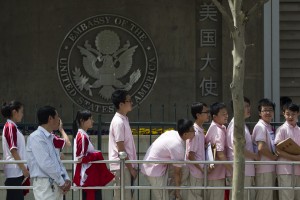
The number of international students studying at U.S. colleges increased by 10 percent last year, marking the largest single-year gain in 35 years, according to new federal data. Meanwhile, the number of Americans studying abroad grew by only 5 percent, falling short of expectations.
The findings were released Monday from an annual study by the nonprofit Institute of International Education and the U.S. Department of State.
Of almost 1 million students that came to the U.S. in the 2014-15 school year, about a third came from China, the most from any country. But much of last year’s growth is credited to a surge in the number of students who came from India, drawn by strong research programs, experts say.
In all, the number of Indian students in the U.S. grew by 30 percent to more than 130,000, the biggest jump since the nonprofit started collecting data in 1954.
“That increase has been primarily at the graduate level, and we know that Indian students have always been very attracted to the availability of excellent science and research facilities on U.S. campuses,” said Rajika Bhandari, the nonprofit’s deputy vice president for research and evaluation.
Numbers coming from Brazil spiked, too, from 13,000 to 23,000, but Brazilians still made up only 2 percent of international students in the U.S.
For the second consecutive year, New York University hosted the largest number of international students at more than 13,000. It’s followed by the University of Southern California, Columbia University and Arizona State University, which each hosted more than 11,000 international students last year.
At the University of Southern California, the number of Indian students has gone from 1,300 to more than 2,000 since 2012. At other schools like Harvard University and the Massachusetts Institute of Technology, populations of Indian students have increased over time but held steady in recent years.
“A master’s degree in the U.S. is generally considered quite a bit more advanced than ones in India,” said Phani Kiran, who came to Arizona State from India last year to get a master’s in electrical engineering. “I did have options to do it in India as well, but I kind of wanted more global exposure.”
About 700 students came to Arizona State from India last year, Kiran said, up from about 550 the year before.
The Institute of International Education reported that international students contributed $30 billion to the U.S. economy last year.
The U.S. remains the top destination for international students, but relatively few Americans study abroad. About 300,000 U.S. students left the country to study in the 2013-14 school year, the most recent year for which figures for Americans are available — a number that has risen steadily but still accounts for less than 2 percent of all U.S. undergraduate students.
“This rate of growth is not good enough,” Bhandari said. “We really do need to double or even triple this rate of growth.”
To boost those numbers, the U.S. Department of State said it’s opening a new study abroad office offering information on programs and scholarships.
“We are going to be working very actively on outreach to explain the benefits of study abroad and encourage more Americans to participate,” said Marianne Craven, the acting deputy assistant secretary of state for academic programs. The office plans to launch its website this week, Craven said.
In particular, the office hopes to help more low-income and minority students. About 75 percent of U.S. students who studied abroad last year were white, a ratio that has decreased only slightly over the past decade. Black students made up 6 percent of students who studied abroad last year.
Top destinations for U.S. students are the United Kingdom, Italy and Spain. European countries drew half of all U.S. students who studied abroad.
Colleges, too, have been pushing students to study abroad for years, citing the benefits of cultural exchange. Dozens have signed on to a national campaign encouraging all students to get passports. Universities have also ramped up efforts to recruit international students, especially in growing regions.
“They know that attracting international students to their campuses makes for a better student body,” Craven said.




